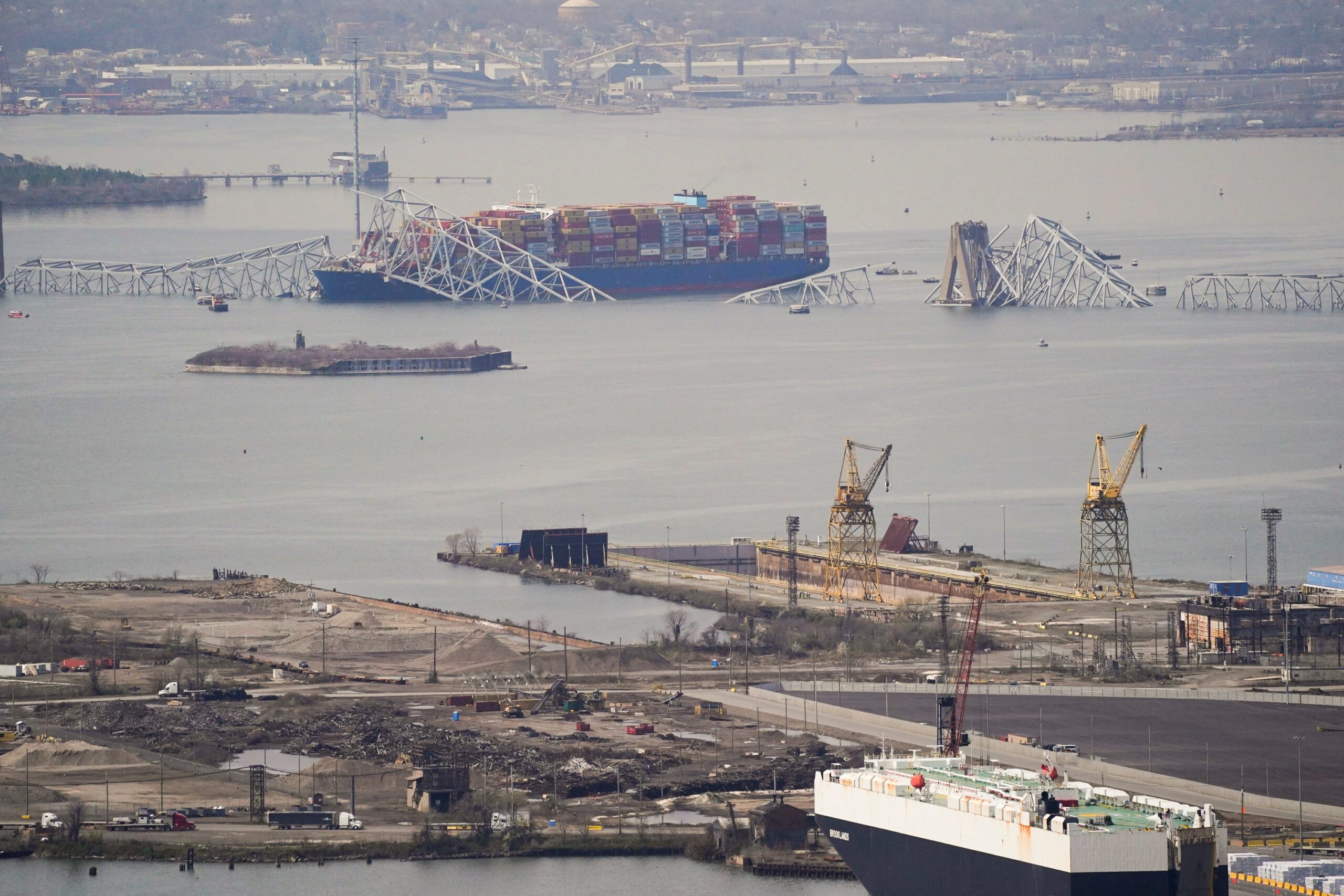or oversized loadsAnd - SIAP - those tunnels can't carry hazmat...
Francis Scott Key bridge collapse (Baltimore)
- Thread starter 92tide
- Start date
You are using an out of date browser. It may not display this or other websites correctly.
You should upgrade or use an alternative browser.
You should upgrade or use an alternative browser.

Very sad breaking news out of Baltimore…..yet another allision. M.V. “Dali”
yea, usually those checklists are all perfect and smell rosy!, I"ve had propulsion go off line at sea, we eventually found a small button in the bottom of one of the switch panels not flickering the same as the others and when pushed everything lit up. I think that only happened twice in 3...
I’ve posted links to this forum before and didn’t have any issues, but the language can be a little salty sometimes. I didn’t see anything that would run afoul of TF policy so far.
This is a thread discussing the incident by a group of professional mariners both US based and abroad. Very knowledgeable group that includes at least one former Maryland pilot
Here's another video by the same guy in the video I posted yesterday. I got it from the forum Tug posted above. He synchronizes the ships path and speed on a map with the real time footage of the ship.
I was wanting an overhead view like that.Here's another video by the same guy in the video I posted yesterday. I got it from the forum Tug posted above. He synchronizes the ships path and speed on a map with the real time footage of the ship.
Disclaimer: I know precisely jack about boat handling.
I had been wondering why the ship was so close to the bridge support in the first place; based on the video, the standard channel went right by the support, as opposed to going down the middle. I assume that the path is determined by channel depth, but that track doesn't seem to give the ship a particularly large margin of error.
I really appreciate your expertise here, Tug. I'm trying to work my way through the forum. Some of it is over my head or unclear. In the post below, I'm unclear on what he's talking about with direct or indirect. Can you clarify?
Very sad breaking news out of Baltimore…..yet another allision. M.V. “Dali”
yea, usually those checklists are all perfect and smell rosy!, I"ve had propulsion go off line at sea, we eventually found a small button in the bottom of one of the switch panels not flickering the same as the others and when pushed everything lit up. I think that only happened twice in 3...forum.gcaptain.com
I’ve posted links to this forum before and didn’t have any issues, but the language can be a little salty sometimes. I didn’t see anything that would run afoul of TF policy so far.
This is a thread discussing the incident by a group of professional mariners both US based and abroad. Very knowledgeable group that includes at least one former Maryland pilot
244
20h
A tug working indirect can have substantial effect on a vessel behind it in stopping or direction.
However the speeds involved in this incident were somewhere between direct and indirect.
Please a tugmaster jump in here.
As I understood it you have to be doing over 10kts for a tug to be effective indirect, hey and it looked awful scary from my point of view, then somewhere between 10 and 6 kts a tug is much better direct.
Please tugmasters jump in here.
My experience with tugs is from driving conventials, to being a pilot with twin voiths or twin ASDs.
Bridges aren’t designed to be rammed by shipsThe way the whole thing collapsed so fast made it look kind of flimsy.
So now it is coming out from port workers that the ship had 2 days of electrical "severe" problems at dock and left anyway.
Dali cargo ship suffered 'severe electrical problem' while docked in Baltimore days prior to bridge collapse crash that saw it suffer 'total power failure, loss of engine failure', port worker says | Daily Mail Online
Dali cargo ship suffered 'severe electrical problem' while docked in Baltimore days prior to bridge collapse crash that saw it suffer 'total power failure, loss of engine failure', port worker says | Daily Mail Online
So now it is coming out from port workers that the ship had 2 days of electrical "severe" problems at dock and left anyway.
Dali cargo ship suffered 'severe electrical problem' while docked in Baltimore days prior to bridge collapse crash that saw it suffer 'total power failure, loss of engine failure', port worker says | Daily Mail Online
Ruh-roh.
Ruh-roh.
Yeah they are saying the reefers (refrigerated containers) were tripping breakers and causing complete loss of power. If that is the case, they obv didn't get to the root cause of the issue before leaving.

Utah lawmaker blames 'diversity' for Baltimore bridge collapse
Phil Lyman, a state representative, retweeted and commented on a post that focused on a commissioner for the Port of Baltimore who is a Black woman.
Sigh. Stupidity is very abundant these days. So is blatant racism, like in this case.
Last edited:
It used to be my job to drive ships under bridges. Things do go wrong
One of the problems with ‘dropping the plant’ is that the resultant equipment failures are never the same. Have you lost propulsion? If ‘no’, do you still have control over it or is it stuck at whatever setting you last ordered? How long before you can switch over to backup systems? Critically, do you have control over the rudder, if not, what angle is that stuck at? While you work this out you must ask are you navigationally safe and if not, how long have you got?
they can't help themselves. but it's uncivil to point that out.
Utah lawmaker blames 'diversity' for Baltimore bridge collapse
Phil Lyman, a state representative, retweeted and commented on a post that focused on a commissioner for the Port of Baltimore who is a Black woman.www.nbcnews.com
Sigh. Stupidity is very abundant these days. So is blatant racism, like in this case.
it's going to get worse
Last edited:
Indirect would be a tug on line ties to the stern of the ship. It could back down hard to slow the ship, or pull to one side or the other to help steer the stern (same for a center lead forward of the bow, except the slowing down)I really appreciate your expertise here, Tug. I'm trying to work my way through the forum. Some of it is over my head or unclear. In the post below, I'm unclear on what he's talking about with direct or indirect. Can you clarify?
Direct would be a tug with a line up on either the forward or aft quarter of the ship, directly pushing on the ship.
HEADS UP, there is a link going around for an article from the SanFranChronicle about ISIS claiming responsibility. If you click it you’ll get an eye full of a rather large man’s large manparts
PM, if you want the link to send to your buddy
🤣🤦ðŸÂ¼â€Â♂ï¸Â
PM, if you want the link to send to your buddy
🤣🤦ðŸÂ¼â€Â♂ï¸Â

East Coast Ports Work To Reroute Baltimore Cargo
By David Lawder (Reuters) – The catastrophic bridge collapse that closed the Port of Baltimore to ship traffic is unlikely to trigger a major new U.S. supply chain crisis or spike goods prices, due...
 gcaptain.com
gcaptain.com
somebody's got some 'splainin' to doSo now it is coming out from port workers that the ship had 2 days of electrical "severe" problems at dock and left anyway.
Dali cargo ship suffered 'severe electrical problem' while docked in Baltimore days prior to bridge collapse crash that saw it suffer 'total power failure, loss of engine failure', port worker says | Daily Mail Online
Heavy duty crane arrives at bridge
The Chesapeake 1000 crane -- capable of lifting roughly 2.2 million pounds at a time -- arrived at the bridge at 11 p.m. Thursday, according to the bridge response Unified Command.
The piece of steel on the bow of the ship weighs roughly 9 million pounds.
Engineers will need to figure out exactly how and where to cut the steel to ensure no further danger will be posed to construction crews or the ship, the Unified Command said. Once the engineers determine where and how to cut the steel, they will begin to remove it from the ship in multiple pieces, the Unified Command said.
One crane has arrived.......
BALTIMORE (AP)  A crane appeared at the site of a collapsed highway bridge in Baltimore as crews prepared Friday to begin clearing wreckage that has stymied the search for four missing workers and blocked ships from entering or leaving the city’s vital port.
A crane that can lift 1,000 tons  described the largest on the Eastern Seaboard  had been expected to arrive late Thursday, and a second that can lift 400 tons should arrive Saturday, officials said earlier. They will be used to clear the channel of the twisted metal and concrete remnants of the Francis Scott Key Bridge, as well as the cargo ship that hit it this week.

 apnews.com
apnews.com
BALTIMORE (AP)  A crane appeared at the site of a collapsed highway bridge in Baltimore as crews prepared Friday to begin clearing wreckage that has stymied the search for four missing workers and blocked ships from entering or leaving the city’s vital port.
A crane that can lift 1,000 tons  described the largest on the Eastern Seaboard  had been expected to arrive late Thursday, and a second that can lift 400 tons should arrive Saturday, officials said earlier. They will be used to clear the channel of the twisted metal and concrete remnants of the Francis Scott Key Bridge, as well as the cargo ship that hit it this week.
As cranes arrive at Baltimore bridge collapse site, governor describes daunting task of cleaning up
A crane that can lift 1,000 tons has appeared near the site of a collapsed highway bridge in Baltimore as crews prepare to begin clearing wreckage.
New Posts
-
-
Bama Game Thread: MBB Bama vs Illinois (Chicago) - FS1 - 8pm CST (Wed Nov 19)
- Latest: AlistarWills
-
-
Trending content
Latest threads
-
CFN: Alabama vs Eastern Illinois Prediction: The Crimson Tide Will Be Fine
- Started by crimsonaudio
- Replies: 1
-
JessN: Eastern Illinois preview: Bama picks no-bite Panthers as Auburn precursor
- Started by JessN
- Replies: 0
-
-
-
Eastern Illinois Preview: Bama picks no-bite Panthers as Auburn precursor
- Started by JessN
- Replies: 0
-





